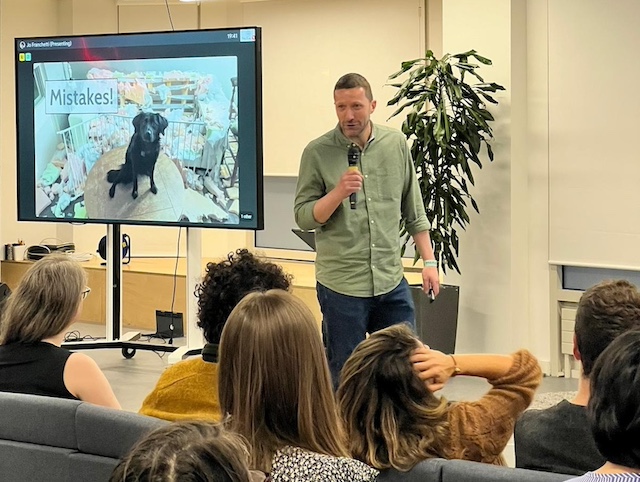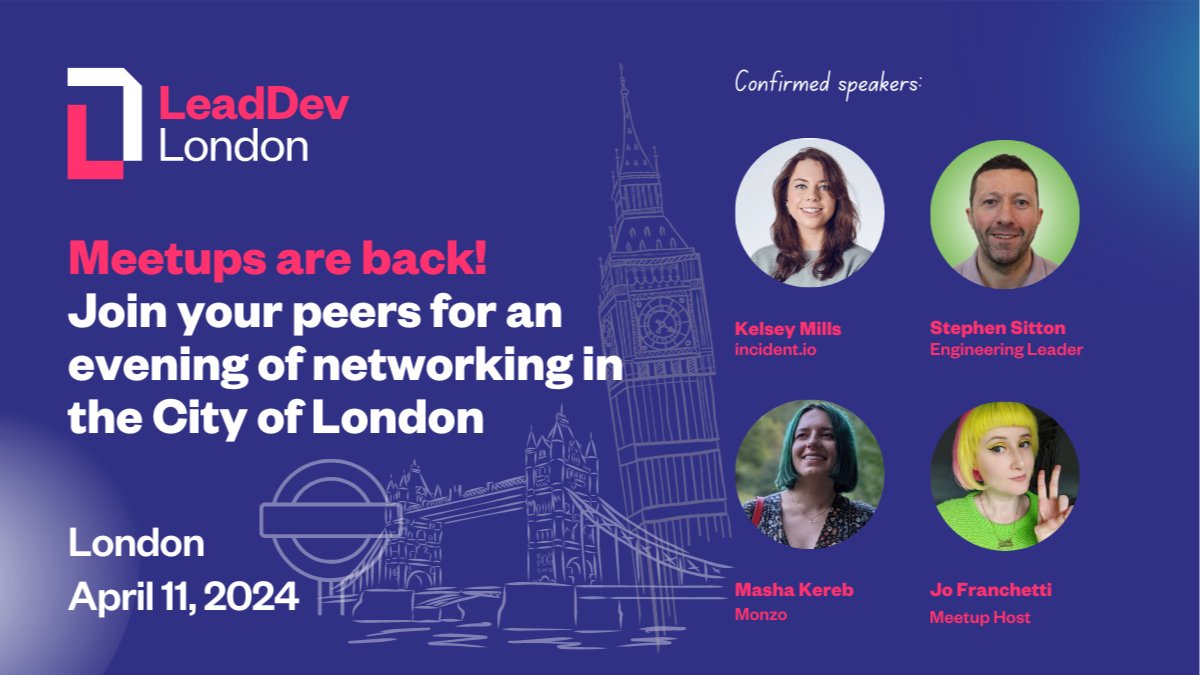I had the pleasure of speaking at the relaunch of LeadDev’s London Meetups on 11th April.
Below are my notes from the talk. There’s no video recording of the evening.
My talk was titled – Turn leadership mistakes into a better future.
Leadership mistakes can be more visible and potentially have a big impact. They can affect individual people, teams, or even the whole business. It’s then important we’re learning from these mistakes.
These are examples of some mistakes that I’ve made in my career. I’ll cover the impact of these mistakes but also how we can learn from these to create a better future for those around us.
Mistake: Tunnel vision on project work
This initially might seem strange because project work is important, teams need to deliver on their commitments to ensure we meet customer demand and help the company grow.
At the same time though we need to ensure we’re creating opportunities for our teams to grow. We need to be building a tech culture that creates an environment of safety and collaboration. A place where people know they have personal growth and have fun at the same time.
When we don’t have the balance right it hurts morale, growth, and innovation.
For a better future…
- Get to know people on a personal level – learn about about their hobbies, interests, what their aspirations are<./li>
- Create opportunities to allow people & teams to grow – once you know what people want you can create opportunities to help them. Maybe it’s exposure to managerial responsibilities to know if that’s right for them. Or getting more experience public speaking. The options are endless, but helping people work on areas outside of BAU work is important.
- Find ways to increase collaboration and team building – breaking down team silos is essential so teams are interacting and learning from each other.
- A healthy tech culture benefits project work – when there’s a good and fun tech culture in place people it boosts project work too because people are more engaged and helping each other.
Mistake: Copying what other companies do
This relates to structure of the teams. The classic example is the Spotify Model. When this first came out there was a lot of buzz and excitement around it, people heard how well it was working for them and wanted the do the same!
There are many good processes and team structures out there but simply copying them doesn’t work. It’s not taking the needs of our business into account. Companies have different product strategies, delivery processes, team structures, visions, and people. These have to be taken into account otherwise you’re trying to force something that in that’s designed for somewhere else. Even more important, what you see in other companies is a snapshot in time of where they are, they constantly evolve as they learn. Spotify quickly moved on from what was first publicised.
For a better future…
- Understand what you’re trying to solve for – to make changes you first have to understand why? What problem are you trying to fix? Without clearly understanding this, no changes should be made.
- Have a good understanding on the possibilities – there’s a lot of good information out there in books, blogs, videos. Take time to learn about companies or methodologies available to starting thinking about options.
- Look for patterns – once you know the problem you’re solving and different options, look for similarities/patterns that could work or suit your environment.
- Experiment with small groups – test out your thinking in one team. Work with them on what works and what doesn’t. Scale out if it solves the problem, otherwise rethink. Whatever route you choose, constantly evolve and learn as you go.
Mistake: Not reading the signals
This is focused on interactions with other people. If we’re not reading the signals correctly we might be negatively affecting their needs.
Sometimes people need space to let frustration out without getting into a dialogue about potential ways forward. There could also be potential mental health signals being displayed that if not handled correctly might make the situation worse.
For a better future…
- Learn about your people to identify their needs – know people’s baseline, what are they normally like (energetic, quiet). If you don’t know this, you don’t know when they’re not quite themselves.
- Improve your knowledge on mental health topics – there’s a lot of good information available on mental health, use it to improve your knowledge. Also, understand what your company offers for professional help.
- Improve in spotting the signals – with a better understanding you can spot the signals and make more informative decisions. Do I just need to listen? Does this person need more professional guidance I can point them to?
- We can all help to look out for each other – no matter our role, we can all look out for those around us. It’s even more important in our remote/hybrid world where we don’t know what someone is going through behind the screen. If we can spot the signals that something doesn’t seem normal we can check-in on them and see if they need anything.
Mistake: Ignoring the onboarding experience
First impressions are important! We’ve all started new jobs, we have energy and excitement, we want to show they’ve made the right decision in hiring us. A bad onboarding experience can kill enthusiasm very quickly! If it’s really bad you might even lose your new hire.
Having an unstructured onboarding experience can be frustrating and leave a negative experience for the new hire. We want to use the energy and excitement they’re bringing to benefit everyone around us.
For a better future…
- Think about how the experience is for your new hires – put yourself in their shoes, would you enjoy onboarding in your company? Some companies have processes that need to be followed, are these dampening the experience? There are things we can’t control, but what is in our control to add excitement?
- Create fun activities/missions – think how you can add fun into the onboarding. At one place, I added a ‘first day mission’. Once they had their IT onboarding done and after few initial intros each new hire what set a mission – push your first change into production! We had a simple page on the platform with everyones photo so we asked the new hires to add their photo. This meant they have to setup their dev environment, make the code change, create a PR and get it reviewed, merge the change and follow the deployment process. Not only did they learn how to get setup and they had some fun during the mission. This is just one example to add some fun into the experience.
- Make introductions, setup coffee chats – help your new hire to start building relationships and getting to know people. It’s even more important if they’re remote. This helps them feel more part of the team early on.
- Create a 30/60/90 day plan with expectations – put structure in place so the new hire knows what’s expected of them. This helps both the manager and the new hire cover the important areas of onboarding into the role and business. When basic knowledge is shared in a haphazard way it comes across very unprofessional.
Mistake: Overlooking recognition
There’s a lot of good work that happens within the product & engineering teams which isn’t recognised. One reason is because it’s hard to get right! But missed opportunities to celebrate good work hurts morale and the tech culture so it’s essential to find something that works.
For a better future…
- Discover the good work people/teams are doing – it can be hard to find out all the good work that is happening, particularly with larger teams. Having nominations is one way to make good work more visible. Find ways to make good work more visible.
- Ensure the right behaviour/work is recognised – rewarding the behaviour you want others to follow is important. If you celebrate actions that lead to unhealthy work habits it could lead to these behaviours being adopted by your teams.
- Be creative with recognition – it’s a great opportunity to create something personalised and lasting to show how valued people are. One idea I’ve used is personalised lego minifigures.
Summary
These are some of mistakes I’ve made. They’re examples of how I learned from them to help create a better future.
I believe leaders should be role models in owning our mistakes. Being honest and transparent about what’s happened and how we will learn from it builds a culture of openness.
Mistakes will happen, especially when we’re pushing the boundaries or trying out new things. If we’re not making mistakes are we really taking the risks needed to take our teams or business to the next level? Many businesses don’t have the luxury of playing it safe.
Sometimes we don’t make changes because we’re worried they might fail or make us look bad. This is why courage is important to drive through this discomfort for the sake of the teams.
If people see you’re taking risks for the right reasons you will get their support and help. Ultimately, it’s about team work. We grow and learn as a team. It’s through working with others and being on the journey together that you will continuously improve to a better future.
Here are the slides from my talk:
A few photos from the evening:





Leave a Reply